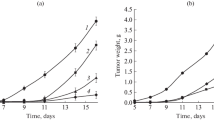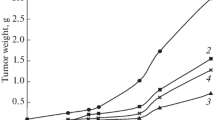Abstract
The antitumor activity of the binuclear form of dinitrosyl iron complexes with glutathione against Lewis lung carcinoma was found earlier with intraperitoneal administration of the complexes. This activity was also observed when this preparation was injected subcutaneously. The complex inhibited the tumor growth by 43% upon subcutaneous injection at a daily dose of 100 µM/kg (as calculated per one iron atom in the binuclear dinitrosyl iron complex) for 10 or 15 days. The effect was observed during the first 2 weeks after tumor transplantation. After this, the tumors began to grow at a rate that was equal to or even higher than that for the control animals. The mean survival time for the treated mice exceeded the control values by 30%. Binuclear dinitrosyl iron complexes were also effective against Ca-755 adenocarcinoma with intraperitoneal administration. In this case, however, the mean survival time for the treated animals only increased by 7%. It was also shown that S-nitrosoglutathione inhibited the growth of Lewis lung carcinoma and Ca-755 adenocarcinoma by 70 and 90%, respectively. However, in contrast to binuclear dinitrosyl iron complexes, the antitumor effect of S-nitrosoglutathione decreased with an increase in the daily dose of the compound from 200 to 400 µM/kg. The initial antitumor effect of binuclear dinitrosyl iron complexes and S-nitrosoglutathione is suggested to be due to NO that is released from both compounds. The subsequent suppression of the effect is caused by the activation of antinitrosative and antioxidant defense systems in tumors.
Similar content being viewed by others
References
A. F. Vanin, L. A. Ostrovskaya, D. B. Korman, et al., Biophysics (Moscow) 59, 415 (2014).
A. F. Vanin, L. A. Ostrovskaya, D. B. Korman, et al., Biophysics (Moscow) 60, 121 (2015).
R. R. Borodulin, L. N. Kubrina, V. O. Shvydkiy, et al., Nitric Oxide Biol. Chem. 35, 110 (2013).
D. L. H. Williams, Nitrosation Reactions and the Chemistry of Nitric Oxide (Elsevier, Amsterdam, 2004).
A. F. Vanin, A. P. Poltorakov, V. D. Mikoyan, et al., Nitric Oxide Biol. Chem. 23, 136 (2010).
E. M. Treshchalina, O. S. Zhukova, G. K. Gerasimova, et al., in A Manual on Experimental (Preclinical) Study of New Pharmacological Substances, 2nd ed., Ed. by R. U. Khabriev (Meditsina, Moscow, 2005) [in Russian].
A. F. Vanin, V. A. Serezhenkov, V. D. Mikoyan, et al., Nitric Oxide Biol. Chem. 2, 234 (1998).
M. I. Brennan, T. Cole, and J. A. A. Singley, Proc. Soc. Exptl. Biol. Med. 123, 715 (1966).
N. M. Emanuel, A. N. Saprin, V. A. Shabalkin, et al., Nature 222, 165 (1969).
T. Mariyama, N. Kataoka, S. Nagase, et al., Cancer Res. 31, 179 (1971).
R. R. Borodulin, L. N. Kubrina, V. D. Mikoyan, et al., Nitric Oxide Biol. Chem. 29, 4 (2013).
J. Mier-Cabrera, S. Gonzalez-Collardo, and C. Hernandez-Guerrero, Reprod. Sci. 2, 132 (2013).
J. Green, M. D. Rolfe, and L. J. Smith, Virulence 5, 1 (2013).
D. Berg, M. B. Youdim, and P. Riederer, Cell Tissue Res. 318, 211 (2004).
E. N. Chazov, O. V. Rodnenkov, A. V. Zorin, et al., Nitric Oxide Biol. Chem. 26, 148 (2012).
E. N. Burgova, N. A. Tkachev, L. V. Adamyan, et al., Eur. J. Pharmacol. 727, 140 (2014).
E. N. Burgova, N. A. Tkachev, L. V. Adamyan, et al., Eur. J. Pharmacol. 741, 37 (2014).
Author information
Authors and Affiliations
Corresponding author
Additional information
Original Russian Text © A.F. Vanin, L.A. Ostrovskaya, D.B. Korman, L.N. Kubrina, R.R. Borodulin, M.M. Fomina, N.V. Bluchterova, V.A. Rykova, A.A. Timoshin, 2015, published in Biofizika, 2015, Vol. 60, No. 6, pp. 1157–1165.
Rights and permissions
About this article
Cite this article
Vanin, A.F., Ostrovskaya, L.A., Korman, D.B. et al. The antitumor activity of the S-nitrosoglutathione and dinitrosyl iron complex with glutathione: Comparative studies. BIOPHYSICS 60, 963–969 (2015). https://doi.org/10.1134/S0006350915060263
Received:
Published:
Issue Date:
DOI: https://doi.org/10.1134/S0006350915060263




